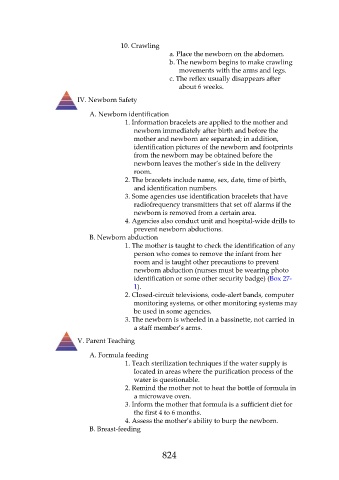Page 824 - Saunders Comprehensive Review For NCLEX-RN
P. 824
10. Crawling
a. Place the newborn on the abdomen.
b. The newborn begins to make crawling
movements with the arms and legs.
c. The reflex usually disappears after
about 6 weeks.
IV. Newborn Safety
A. Newborn identification
1. Information bracelets are applied to the mother and
newborn immediately after birth and before the
mother and newborn are separated; in addition,
identification pictures of the newborn and footprints
from the newborn may be obtained before the
newborn leaves the mother’s side in the delivery
room.
2. The bracelets include name, sex, date, time of birth,
and identification numbers.
3. Some agencies use identification bracelets that have
radiofrequency transmitters that set off alarms if the
newborn is removed from a certain area.
4. Agencies also conduct unit and hospital-wide drills to
prevent newborn abductions.
B. Newborn abduction
1. The mother is taught to check the identification of any
person who comes to remove the infant from her
room and is taught other precautions to prevent
newborn abduction (nurses must be wearing photo
identification or some other security badge) (Box 27-
1).
2. Closed-circuit televisions, code-alert bands, computer
monitoring systems, or other monitoring systems may
be used in some agencies.
3. The newborn is wheeled in a bassinette, not carried in
a staff member’s arms.
V. Parent Teaching
A. Formula feeding
1. Teach sterilization techniques if the water supply is
located in areas where the purification process of the
water is questionable.
2. Remind the mother not to heat the bottle of formula in
a microwave oven.
3. Inform the mother that formula is a sufficient diet for
the first 4 to 6 months.
4. Assess the mother’s ability to burp the newborn.
B. Breast-feeding
824

